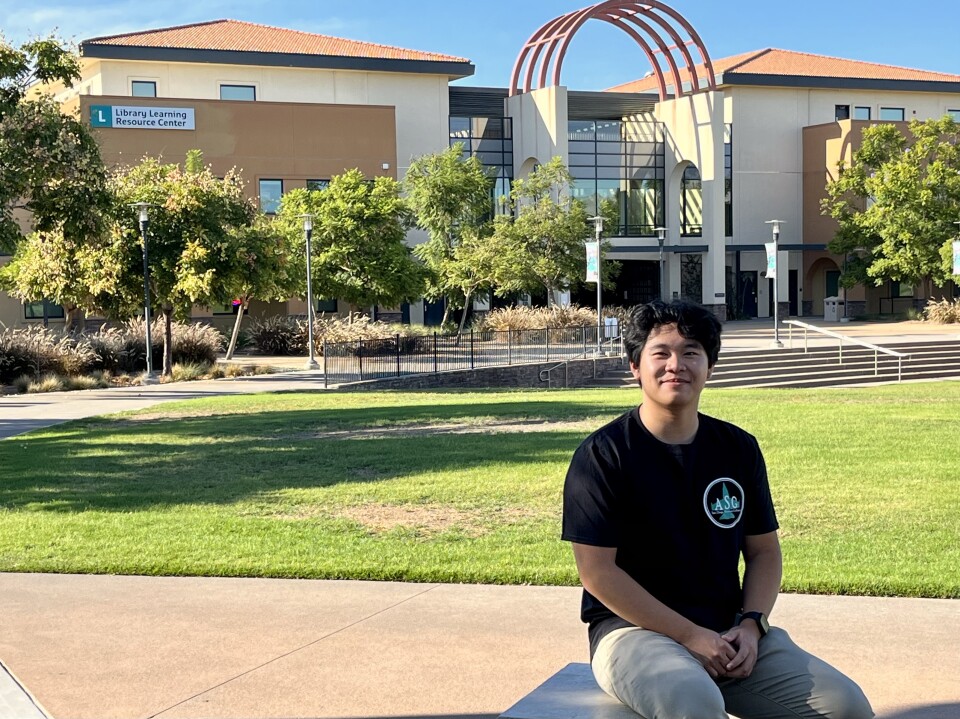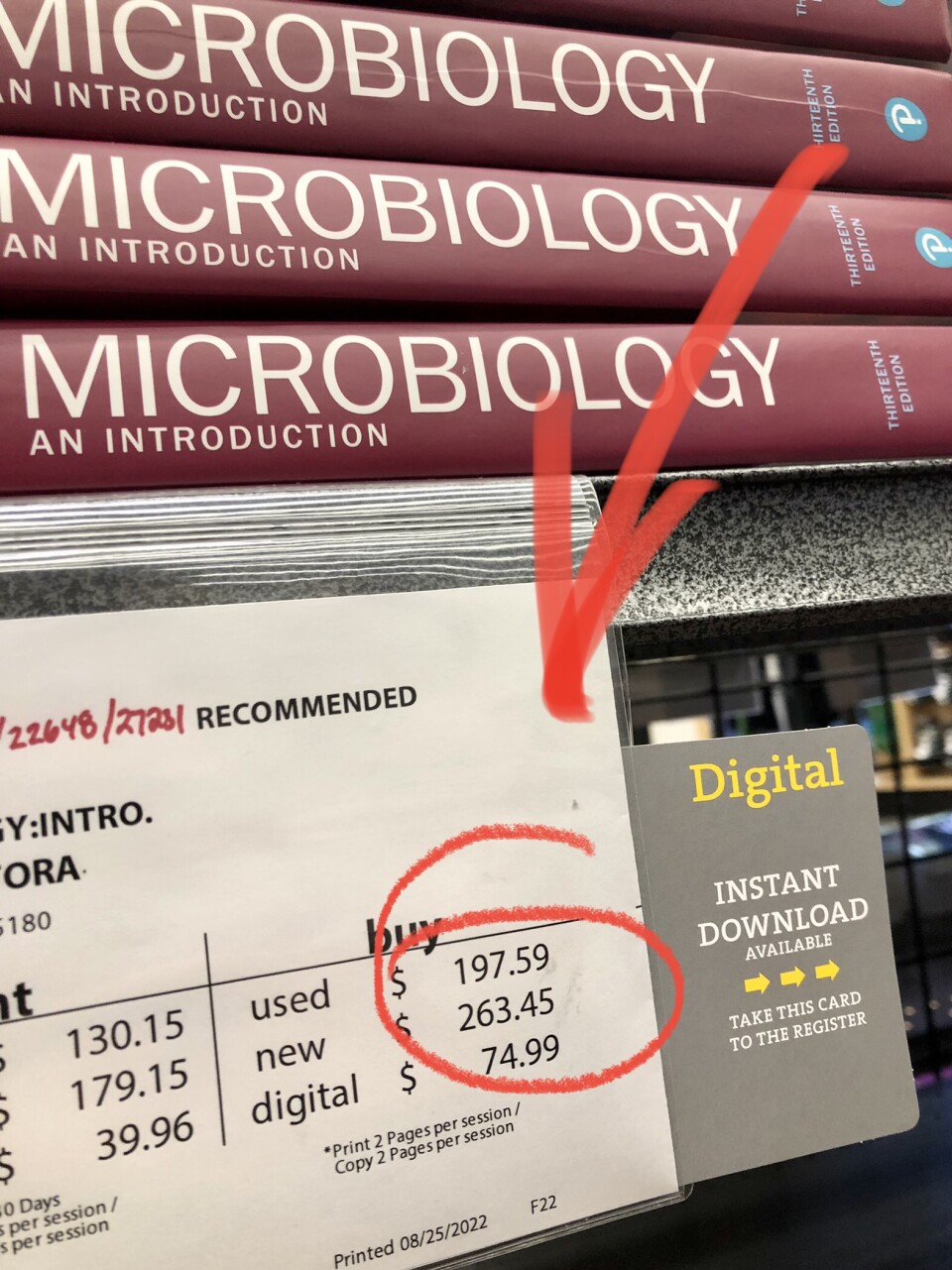Truth matters. Community matters. Your support makes both possible. LAist is one of the few places where news remains independent and free from political and corporate influence. Stand up for truth and for LAist. Make your year-end tax-deductible gift now.
Advocates See A Future Of Zero Textbook Costs For College Students

Miramar College student Allen Kuo has a lot more free time this fall semester. He’s been working at a Chinese restaurant 25 minutes from his San Diego County campus. But his college costs dropped significantly this year, so he’s been able to cut his work hours down, too.
“This fall I was actually able to dodge all of my textbook costs,” Kuo said.
Zero, zilch, nothing, rien, nada.
He says that last year he paid about $700 for textbooks.
“Not having to worry about an extra cost that sometimes costs even more than the class itself is pretty nice,” he said. “And it kind of takes off some extra stress as well.”
Why Newsom Called Textbooks A 'Racket'
Kuo’s textbook experience is no accident; it’s the result of state and campus efforts to counter rising textbook prices and a publishing industry that Gov. Gavin Newsom has described as a “racket.”
At a California Community Colleges Board of Governors meeting on Tuesday, college administrators ticked off the list of things they’re doing to make graduation day an easier milestone to reach.
Kuo’s campus, and other community colleges, now make it easier for students to look at class schedules and identify the classes with zero textbook costs. Reading material has to pass through rigorous measures to be used for classes so faculty have increased their time spent reviewing material that’s in the public domain and creating homework to go along with the electronic texts. It’s work that takes a lot of time.
This kind of effort produces “open educational resources,” and system leaders want to roll out these free-of-charge materials to all 116 California community college (CCC) campuses.

“It's exciting to see this get to where it is now,” said Roy Shahbazian, a member of the board and a longtime community college professor.
Reducing Non-Tuition Costs
Getting to zero takes money. Sacramento lawmakers recognized that and allocated a one-time $115 million pot of money so community colleges could get there.
How To Get To College In California
Higher education promises a lot of things: jobs, better pay, fantastic opportunities, lifelong success. But trying to make it all happen is, uh, not so straightforward. LAist can't make decisions for you, but our guide to navigating college in California can sketch out the landscape — tell you the basics of what’s out there, highlight helpful resources, discuss pros and cons of different options, get honest about financial aid, and point you to real humans who can talk you through it.
“A decade ago using [Open Educational Resources] was a grassroots effort. There might have been one person on the college who was trying to use it,” Shahbazian said, and now there’s a statewide initiative that’s helping community colleges create more classes that don’t require expensive textbooks.
Tuesday’s update to the CCC board reflected educators’ belief that they’re on the verge of helping many students significantly reduce non-tuition costs. And that’s part of a larger effort begun in recent years by community college administrators to help students pay for basic needs such as food, housing, and transportation. The board of governors passed a resolution to that effect in Sept. 2020.
Every dollar counts when you’re a community college student.
“That resolution called for the dismantling of structures that unduly burdened students in need,” said Marty Alvarado, vice chancellor at the California Community Colleges Chancellor’s Office.
How Expensive Do Textbooks Get?
It was partly driven by the publishing industry. During a recent visit to the Golden West College bookstore in Huntington Beach, the most expensive printed textbooks were selling for upward of $200. Used and digital copies are significantly less but even at one-third of the cost, textbooks for a full load of three or four classes add up.

“Every dollar counts when you’re a community college student,” said Geoffrey Baum, executive director of the Michelson Center for Public Policy. His organization supports zero textbook cost efforts.
“What I think would be wise is to empower students to know in advance what things will cost as they are navigating, as they are making registration decisions and enrollment decisions,” he said.
That up-front price tag label for each community college class is a step further than what colleges do now. It’s one of a long list of tasks those involved in the effort inside and outside the community college infrastructure are working on, with the potential to affect teaching across the country.
“It's really important to the whole open educational resource effort that California gets this right,” said Michelle Pilati, the Academic Senate faculty coordinator for CCC's Open Educational Resources Initiative.
What’s the difference between getting it right and wrong? To understand the answer you have to understand that California’s community colleges are run by local trustees and presidents, like school districts. And those bodies will decide how to use their allocations.
Advocates say there are ongoing costs to update the free texts but that updating would cost less than the up-front costs to pay faculty and advisors to create the material in the first place.
It's really important to the whole open educational resource effort that California gets this right.
“It would make a lot of sense to set funds aside [from the $115 million] to update resources,” Pilati said. She’d like to see the updating done on a statewide basis as a way to share the evolving texts with as many campuses as possible.
As the zero textbook cost effort has ramped up in the last several years, some colleges have used seed funds to pay faculty to create Open Educational Resource texts and associated homework that then can be updated with less effort year after year.
“We've also had other colleges that just use the money outright to purchase digital textbooks for their students,” Pilati said. But that’s like the old proverb — giving a person a fish when they’re hungry, rather than teaching them how to fish.








